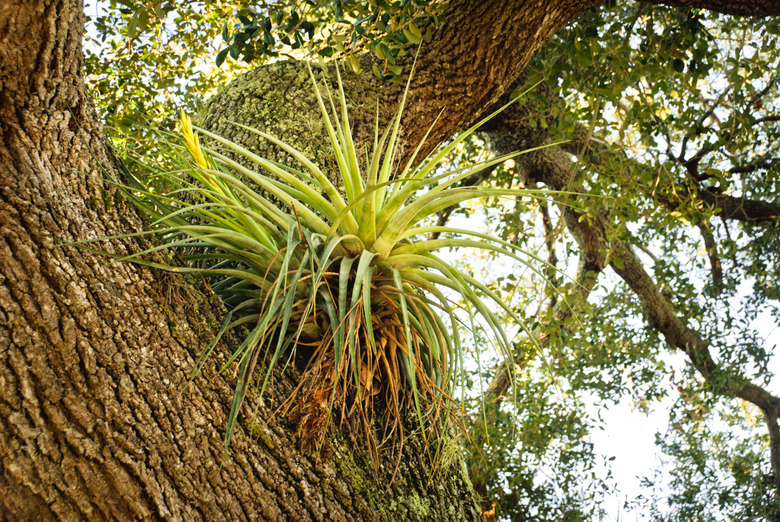Interactions Between Bromeliads & Wild Tamarind Trees
Many U.S. gardeners know bromeliads (Bromeliaceae) as container-grown houseplants with strappy, colorful foliage and exotic blooms.
Many U.S. gardeners know bromeliads (Bromeliaceae) as container-grown houseplants with strappy, colorful foliage and exotic blooms. However, in the heart of the Florida Everglades, native bromeliads interact with wild tamarind trees (Lysiloma latilisiliquum) in a different growing environment, as they take up residence on the receptive tree. The striking pairing isn't lost on savvy, warm-climate gardeners. Wild tamarind tree and bromeliads team up in home gardens as well.
Understanding Bromeliads
With thousands of species spanning deserts to rainforests, bromeliads live on rocks, soil or trees. Most commonly cultivated bromeliads like those found on wild tamarind are tree-dwelling plants known as epiphytes. In native habitats, their specialized roots cling to tree trunks and branches — taking nothing but support from trees. Epiphytic bromeliads draw their water and nutrients from air and moisture that accumulates between their leaves. The native bromeliad Spanish moss (Tillandsia usneoides) flourishes in U.S. Department of Agriculture plant hardiness zones 8 through 11, but many more colorful bromeliads require frost-free USDA zones 10 through 12.
Taming Wild Tamarind
After finding its way from the West Indies to Florida, wild tamarind took hold among the Everglades' hardwood trees. Hardy from USDA zones 10b through 12, the tree's dense canopy withstands tough weather and strong winds. At one time, the extent of its U.S. population was in Florida's wilds. Growing swiftly and gracefully to 50 feet in height and width, it's now cultivated for its form and shade. The tree's large trunk can reach 3 feet in diameter. Smooth young bark matures into rough, scale-like plates that welcome bromeliad's air roots. Wild tamarind prefers full sun and moist, well-drained, low-nutrient soil. Drought-tolerant mature trees rarely need supplemental water.
Choosing Companions
A successful garden pairing with wild tamarind requires epiphytic bromeliads. Only epiphytes can exist in the soil-free environment provided on wild tamarind bark. Native bromeliads — many endangered in the Everglades, but cultivated by native nurseries — include West Indian tufted airplant (Guzmania monostachia), suited to USDA zones 10 through 11, and leatherleaf airplant (Tillandsia variabilis), fitting for USDA zones 9b through 11. These and other species from these two genera cultivate well, offering fragrant flowers and unusual, colorful foliage. Non-native epiphytic bromeliads will be at home on wild tamarind, too.
Making the Match
To find lasting footholds, epiphytes need wild tamarind's scaly bark. Temporary connections duplicate the effect, but lasting interaction requires more. Wrap the bromeliad's base and roots in damp sphagnum moss. Attach the wrapped base to wild tamarind's trunk or branch. Use plastic-coated wire to protect the roots, and tie it so wire removal stays simple. Choose a spot with plentiful light, protected from direct sun. Use a gentle hose spray to thoroughly wet the moss and plant, and continue frequent watering so the moss stays damp. After support roots grow and take hold on wild tamarind, remove the temporary holding wire. Keep the bromeliad hydrated with regular watering throughout the year.
References
- University of Florida Cooperative Extension Service: Bromeliads
- The Institute for Regional Conservation: Wild-Tamarind, False Tamarind
- University of Florida IFAS Lee County Extension: Lysiloma Latisiliquum
- Missouri Botanical Garden: Bromeliaceae Epiphyte
- Zipcodezoo.com: Guzmania Monostachia
- Zipcodezoo.com: Tillandsia Variabilis
